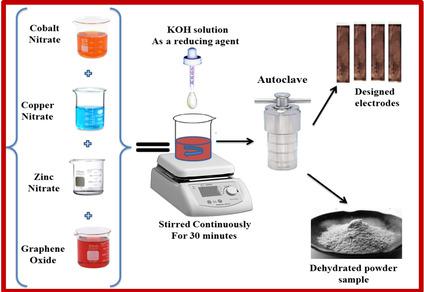当前位置:
X-MOL 学术
›
Electroanalysis
›
论文详情
Our official English website, www.x-mol.net, welcomes your
feedback! (Note: you will need to create a separate account there.)
Evaluation of 8.0 MeV Carbon (C2+) Irradiation Effects on Hydrothermally Synthesized Co3O4−CuO−ZnO@GO Electrodes for Supercapacitor Applications
Electroanalysis ( IF 2.7 ) Pub Date : 2020-10-09 , DOI: 10.1002/elan.202060382 Raphael M. Obodo 1, 2, 3 , Muhammad Asjad 2 , Assumpta C. Nwanya 1, 4, 5 , Ishaq Ahmad 2, 3, 5 , Tingkai Zhao 3, 6 , A. B. C. Ekwealor 1 , Paul M. Ejikeme 7 , Maalik Maaza 4, 5 , Fabian I. Ezema 1, 4, 5
Electroanalysis ( IF 2.7 ) Pub Date : 2020-10-09 , DOI: 10.1002/elan.202060382 Raphael M. Obodo 1, 2, 3 , Muhammad Asjad 2 , Assumpta C. Nwanya 1, 4, 5 , Ishaq Ahmad 2, 3, 5 , Tingkai Zhao 3, 6 , A. B. C. Ekwealor 1 , Paul M. Ejikeme 7 , Maalik Maaza 4, 5 , Fabian I. Ezema 1, 4, 5
Affiliation

|
Combination of transition metal oxides and carbon derivatives have received a lot of interest in last two decades for electrochemical energy storage due to their small size and high specific surface area. The effects of carbon ion irradiation on the properties of the electrodes were examined. The structural properties as obtained from the X‐ray diffraction (XRD) results suggest that irradiation of the nanocomposite enhances the crystallinity of the materials up to the optimal dose of 5.0×1015 ions/cm2. Beyond this dose, there was a reduction in the crystallinity occasioned by distortion and defects in the structure of the material. The morphological studies indicated that the nanocomposites have spherical nanoparticles with some agglomerations. The agglomerations as well the particle sizes reduced with increase in the radiation dosages. The energy bandgaps estimated for the Co3O4−CuO−ZnO@GO reduced as energy dosages increases. The highest specific capacitance obtained from cyclic voltammetry (CV) plots at 10 mV/s scan rate and galvanostatic charge‐discharge (GCD) were 1950 and 2045 F/g at a radiation dose of 5.0×1015 ions/cm2. Results indicate that carbon ion irradiations, especially low doses enhance the characteristics performance of these electrodes while high doses induce deficiencies and disorder to the Co3O4−CuO−ZnO@GO electrodes. These results also indicate that radiation is a useful tool to enhance or damage properties of nanomaterials especially with low energy doses.
中文翻译:

8.0 MeV碳(C2 +)辐射对超级电容器应用水热合成Co3O4-CuO-ZnO @ GO电极的影响
在过去的二十年中,过渡金属氧化物和碳衍生物的组合因其尺寸小和比表面积大而备受关注,用于电化学储能。研究了碳离子辐照对电极性能的影响。从X射线衍射(XRD)结果获得的结构特性表明,纳米复合物的辐照可提高材料的结晶度,直至最佳剂量为5.0×10 15 离子/ cm 2为止。超过此剂量,由于材料的变形和缺陷而导致的结晶度降低。形态研究表明,纳米复合材料为球形纳米颗粒,具有一定的团聚性。随着辐射剂量的增加,团聚以及粒径减小。随着能量剂量的增加,对Co 3 O 4 -CuO-ZnO @ GO估计的能带隙减小。循环伏安法(CV)曲线在10 mV / s扫描速率和恒电流充放电(GCD)下获得的最高比电容为1950和2045 F / g,辐射剂量为5.0×10 15 ions / cm 2。结果表明,碳离子辐照,特别是低剂量辐照增强了这些电极的性能,而高剂量辐照则引起了Co 3 O 4 -CuO-ZnO @ GO电极的缺陷和无序。这些结果还表明辐射是增强或破坏纳米材料特性的有用工具,尤其是在低能量剂量下。
更新日期:2020-12-01
中文翻译:

8.0 MeV碳(C2 +)辐射对超级电容器应用水热合成Co3O4-CuO-ZnO @ GO电极的影响
在过去的二十年中,过渡金属氧化物和碳衍生物的组合因其尺寸小和比表面积大而备受关注,用于电化学储能。研究了碳离子辐照对电极性能的影响。从X射线衍射(XRD)结果获得的结构特性表明,纳米复合物的辐照可提高材料的结晶度,直至最佳剂量为5.0×10 15 离子/ cm 2为止。超过此剂量,由于材料的变形和缺陷而导致的结晶度降低。形态研究表明,纳米复合材料为球形纳米颗粒,具有一定的团聚性。随着辐射剂量的增加,团聚以及粒径减小。随着能量剂量的增加,对Co 3 O 4 -CuO-ZnO @ GO估计的能带隙减小。循环伏安法(CV)曲线在10 mV / s扫描速率和恒电流充放电(GCD)下获得的最高比电容为1950和2045 F / g,辐射剂量为5.0×10 15 ions / cm 2。结果表明,碳离子辐照,特别是低剂量辐照增强了这些电极的性能,而高剂量辐照则引起了Co 3 O 4 -CuO-ZnO @ GO电极的缺陷和无序。这些结果还表明辐射是增强或破坏纳米材料特性的有用工具,尤其是在低能量剂量下。











































 京公网安备 11010802027423号
京公网安备 11010802027423号